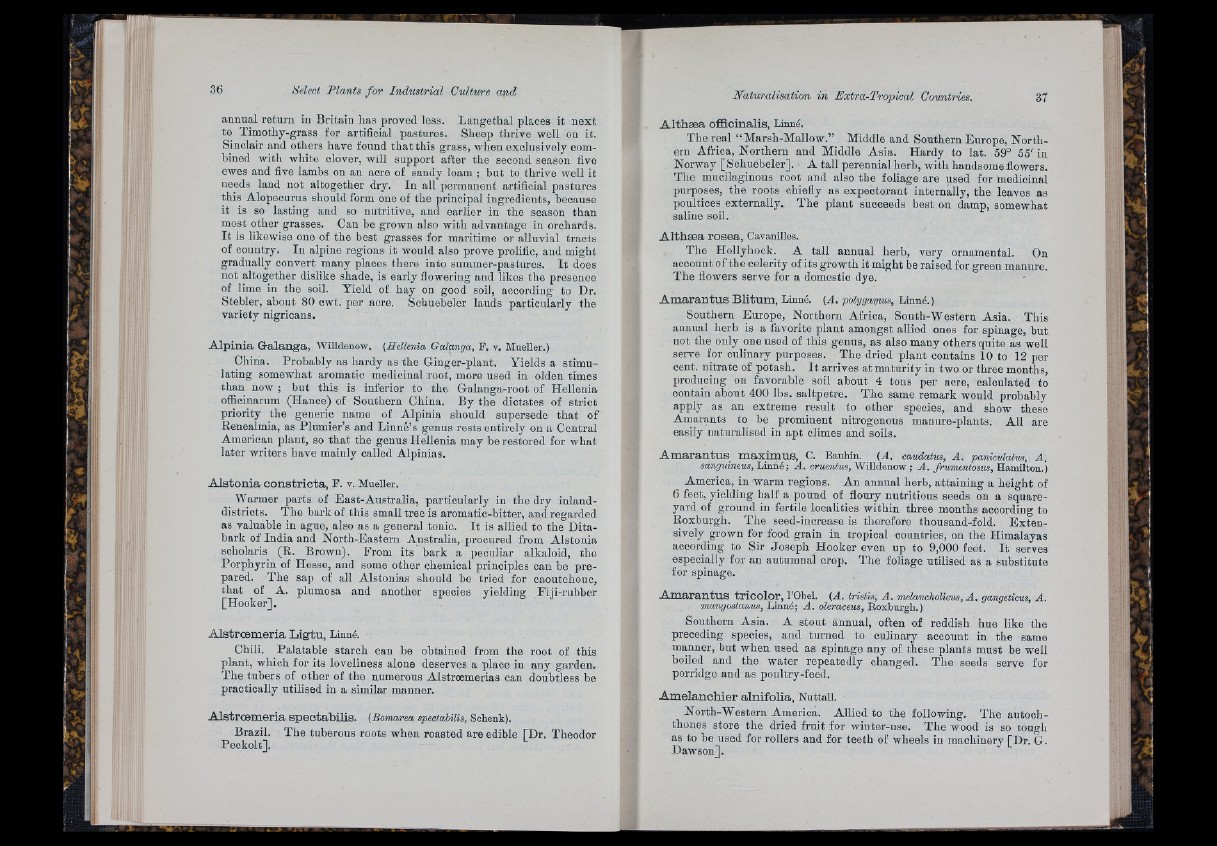
annual return in Britain has proved less. Langethal places it next
to Timothy-grass for artificial pastures. Sheep thrive well on it.
Sinclair aud others have found th a t this grass, when exclusively combined
with white clover, will support after the second season five
ewes and five lambs on an acre of sandy loam ; but to thrive well it
needs land not altogether dry. In all permanent artificial pastures
this Alopecurus should form one of the principal ingredients, because
it is so lasting aud so nutritive, and earlier in the season than
most other grasses. Can be grown also with advantage in orchards.
I t is likewise one of the best grasses for maritime or alluvial tracts
of country. In alpine regions it would also prove prolific, and might
gradually convert many places there into summer-pastures. I t does
not altogether dislike shade, is early flowering and likes the presence
of lime in the soil. Yield of hay on good soil, aoeording to Dr.
Stebler, about 80 cwt. per acre. Schuebeler lauds particularly the
variety nigricans.
A lp in ia G a lan g a , Willdenow. (HelUnia Galanga, F. v. Mueller.)
China. Probably as hardy as the Ginger-plant. Yields a stimulating
somewhat aromatic medicinal root, more used in olden times
than now ; but this is inferior to the Galanga-root of Hellenia
officinarnm (Hance) of Southern China. By the dictates of strict
priority the generic name of Alpinia should supersede th a t of
Reneaimia, as Plumier’s and Linne’s genus rests entirely on a Central
American plant, so that the genus Hellenia may be restored for what
later writers have mainly called Alpinias.
A ls to n ia c o n s tr ic ta , F. v. Mueller.
I/V armer parts of East-Australia, particularly in the dry iuland-
districts. The hark of this small tree is aromatic-bitter, and regarded
as valuable in ague, also as a general tonic. I t is allied to the Dita-
hark of India and North-Eastern Australia, procured from Alstonia
scholaris (R. Brown), From its bark a peculiar alkaloid, the
Porphyrin of Hesse, and some other chemical principles can be prepared.
The sap of all Alstonias should be tried for caoutchouc,
th a t of A. plumosa and another species yielding Fiji-rubber
[Hooker].
A ls tro em e ria L ig tu , Linné.
Chili. Palatable starch can be obtained from the root of this
plant, which for its loveliness alone deserves a place in any garden.
The tubers of other of the numerous Alstroemerias can doubtless be
practically utilised in a similar manner.
A ls troe m e r ia sp e c tab iH s. (Bomarea spectaiiUs, Schenk).
Brazil. The tuberous roots when roasted are edible [Dr. Theodor
Peckolt],
A ltb s e a offlcinalis, Linné.
The real “ Marsh-Mallow.” Middle and Southern Europe, Northern
Africa, Northern and Middle Asia. Hardy to lat. 59° 55' in
Norway [Schuebeler], A tall perennial herb, with handsome flowers.
The mucilaginous root and also the foliage are used for medicinal
purposes, the roots chiefly as expectorant internally, the leaves as
poultices externally. The plant succeeds best on damp, somewhat
saline soil.
A lth s e a ro s e a , Cavamlle,s.
The Hollyhock. A tall annual herb, very ornamental. On
account of the celerity of its growth it might be raised for green manure.
The flowers serve for a domestic dye.
A m a r a n tu s B litum , Linné. {A, polygamus, Linné.)
Southern Europe, Northern Africa, South-Western Asia. This
annual herb is a favorite plant amongst allied ones for spinage, but
not the only one used of this genus, as also many others quite as well
serve for culinary purposes. The dried plant contains 10 to 12 per
cent, nitrate of potash. I t arrives at m aturity in two or three months,
producing on favorable soil about 4 tons per acre, calculated to
contain about 400 lbs. saltpetre. The same remark would probably
apply as an extreme result to other species, and show these
Amarants to be prominent nitrogenous manure-plants. All are
easily naturalised in apt climes aud soils.
A m a r a n tu s m a x im u s , C. Bauhin. {A. caudatus, A. paniculatus,, A.
sanguineus, Linné; A. cruentus, Willdenow ; A. frumentosus, Hamilton.)
America, in warm regions. An annual herb, attaining a height of
6 feet, yielding half a pound of floury nutritious seeds on a square-
yard of ground in fertile localities within three months according to
Roxburgh. The seed-iucrease is therefore thousand-fold. E x ten sively
grown for food grain in tropical countries, on the Himalayas
according to Sir Joseph Hooker even up to 9,000 feet. I t serves
especially for an autumnal crop. The foliage utilised as a substitute
for spinage.
A m a r a n tu s tr ic o lo r, robel. (A. tristis, A. melanchoUcus, A. gangeticus, A.
mangostamts, Linné; A. oleraceus, Roxburgh.)
Southern Asia. A stout annual, often of reddish hue like the
preceding species, and turned to culinary account in the same
manner, but when used as spinage any of these plants must be well
boiled and the water repeatedly changed. The seeds serve for
porridge and as poultry-feed.
A m e la n c h ie r a ln ifo lia , Nuttall.
North-Western America. Allied to the following. The autochthones
store the dried fruit for winter-use. The wood is so tough
as to be used for rollers and for teeth of wheels in machinery [Dr. G.
Dawson].